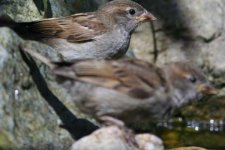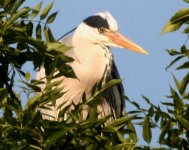Robert L Jarvis
Robert L Jarvis
On the Bird ID page there are a series of photos of a Grasshopper Warbler taken by CJannic using a Canon 300D. It is not clear whether the photos were taken using a) a zoom lens, b) photoadapter attached to scope c) digiscoped using an adapter to bring the camera to the scope. They are good photos but they do highlight an aspect of using a dslr. The bird is not quite in focus and the depth of field is small.
I have a 300D and I have found it difficult at times to get a sharp focus, ,especially if using auto as the camera invariably wants to concentrate on something else. So you switch to manual, and focusing through a scope means using the scope focus or if using an adapter both the scope and camera.
There have been many photos placed here taken using a digiscoped compact and some using a dslr with a zoom but I cannot recall any examples of using a dslr with a zoom on smallish birds or discoping with a dslr. There have been many threads on digisoping or going on the dslr route. Although I have 300D and a variety of lenses, I have given up on this for bird photos and digicsope using a compact digital.
What are the views out there on either method and any examples to support the choice between the two or overcoming the difficulties of using a dslr? What about you members who purchased a special adapter or rail to use the dslr, any examples to show in support of your chosen method?
Robert
I have a 300D and I have found it difficult at times to get a sharp focus, ,especially if using auto as the camera invariably wants to concentrate on something else. So you switch to manual, and focusing through a scope means using the scope focus or if using an adapter both the scope and camera.
There have been many photos placed here taken using a digiscoped compact and some using a dslr with a zoom but I cannot recall any examples of using a dslr with a zoom on smallish birds or discoping with a dslr. There have been many threads on digisoping or going on the dslr route. Although I have 300D and a variety of lenses, I have given up on this for bird photos and digicsope using a compact digital.
What are the views out there on either method and any examples to support the choice between the two or overcoming the difficulties of using a dslr? What about you members who purchased a special adapter or rail to use the dslr, any examples to show in support of your chosen method?
Robert






